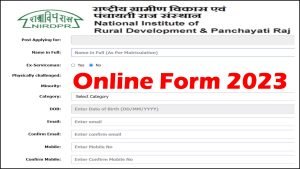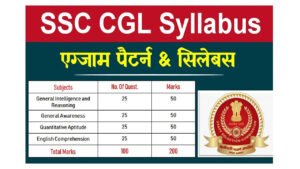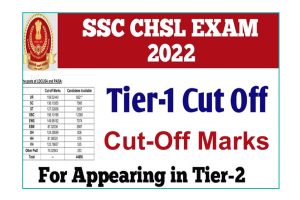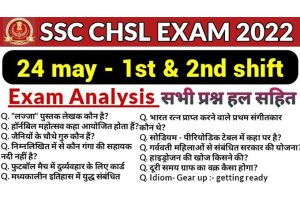SSC CGL Exam Pattern & Syllabus 2023 :- Staff Selection Commission (SSC) has released the notification of CGL. Have changed from fellow exam pattern and syllabus. All the news related to syllabus and exam pattern was told on this page. You have been given complete information about how Tier-I paper will be and Tier-II paper will be on this page. For more details check the official website. To know more information related to syllabus, download the official notification through the link given below and read it thoroughly. SSC CGL Exam Pattern & Syllabus 2023
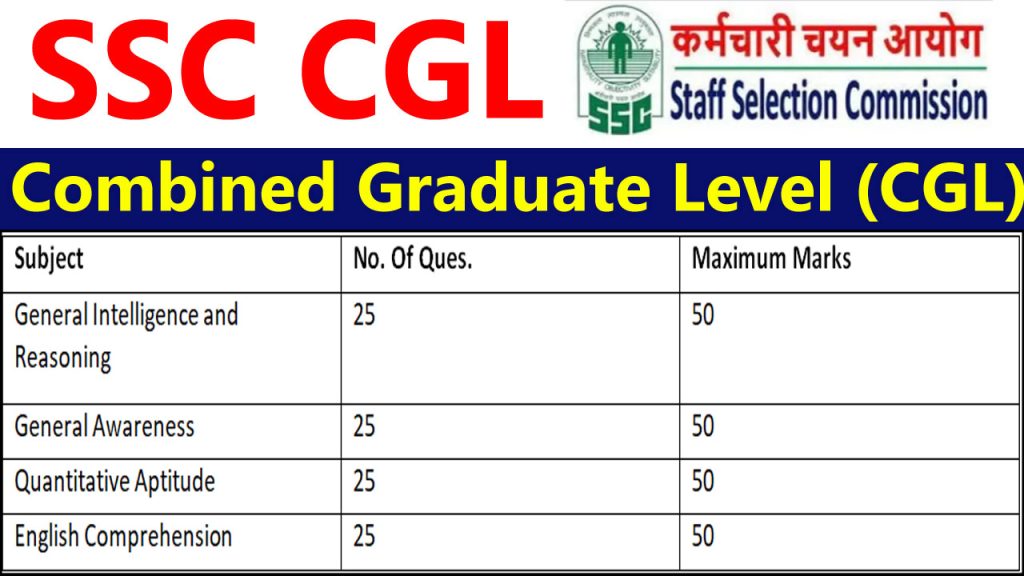
SSC CGL Recruitment Details 2023 Details :-
| Organization | Staff Selection Commission (SSC) |
| Type of Employment | Govt Jobs |
| Total Vacancies | 7500 Posts |
| Location | All India |
| Post Name | Combined Graduate Level (CGL) |
| Official Website | https://ssc.nic.in |
| Applying Mode | Online |
| Apply Date | 03.04.2023 |
| Closing Date | 03.05.2023 |
| Category | CGL Recruitment |
SSC CGL Tier-I Examination :-
| Subject | No. Of Ques. | Maximum Marks |
| General Intelligence and Reasoning | 25 | 50 |
| General Awareness | 25 | 50 |
| Quantitative Aptitude | 25 | 50 |
| English Comprehension | 25 | 50 |
- (1 hour 20 minutes for the candidates eligible for scribe as per Para-7.1, 7.2 and 7.3).
- Tier-I will consist of Objective Type, Multiple choice questions. The questions will be set both in English & Hindi except for English Comprehension.
- There will be negative marking of 0.50 for each wrong answer.
SSC CGL Tier-II Examination :-
| Tier | Paper | Session | Subject | Number of Questions | Maximum Marks | Time allowed |
| II | Paper-I | Session-I (2 hours and 15 minutes) | Section-I: Module-I: Mathematical Abilities Module-II: Reasoning and General Intelligence. | 30 30 Total- 60 | 60*3 = 180 | 1 hour (For each section) |
| Section-II: Module-I: English Language and Comprehension Module-II: General Awareness | 45 25 Total – 70 | 70*3 – 210 | ||||
| Section-III: Module-I: Computer Knowledge Module | 20 | 20*3 – 60 | 15 Minutes (For each module) | |||
| Session-II (15 minutes) | Section-III: Module-II: Data Entry Speed Test Module | One Data Entry Task | – | |||
| Paper-II | Statistics | 100 | 100*2 – 200 | 2 hours (For each Paper) | ||
| Paper-III | General Studies (Finance and Economics) | 100 | 100*2 – 200 | |||
- Tier-II will include conducting of Paper-I, Paper-II and Paper-III in
- separate shift(s)/
- Paper-I is compulsory for all the posts.
- Paper-II will be for only those candidates who apply for the posts of Junior Statistical Officer (JSO) in the Ministry of Statistics and Programmer Implementation and Statistical Investigator Grade-II in the office of Registrar General of India (M/o Home Affairs) and who are shortlisted in Tier-I for these Posts.
- Paper-III will be for only those candidates who are shortlisted in Tier-I
- for Paper-III i.e. for the posts of Assistant Audit Officer/ Assistant Accounts Officer
SSC CGL Tier-I Syllabus :-
General Intelligence & Reasoning :- It would include questions of both verbal and non-verbal type. This component may include questions on analogies, similarities and differences, space visualization, spatial orientation, problem solving, analysis, judgment, decision making, visual memory, discrimination, observation, relationship concepts, arithmetical reasoning and figural classification, arithmetic number series, non-verbal series, coding and decoding, statement conclusion, syllogistic reasoning etc. The topics are, Semantic Analogy, Symbolic/Number Analogy, Figural Analogy, Semantic Classification, Symbolic/Number Classification, Figural Classification, Semantic Series, Number Series, Figural Series, Problem Solving, Word Building, Coding & de-coding, Numerical Operations, symbolic Operations, Trends, Space Orientation, Space Visualization, Venn Diagrams, Drawing inferences, Punched hole/ pattern- folding& un-folding, Figural Pattern-folding and completion, Indexing, Address matching, Date & city matching, Classification of center codes/roll numbers, Small & Capital letters/numbers coding, decoding and classification, Embedded Figures, Critical thinking, Emotional Intelligence, Social Intelligence.
General Awareness :- Questions in this component will be aimed at testing the candidates’ general awareness of the environment around him and its application to society. Questions will also be designed to test knowledge of current events and of such matters of every day observations and experience in their scientific aspect as may be expected of any educated person. The test will also include questions relating to India and its neighboring countries especially pertaining History, Culture, Geography, Economic Scene, General Policy & Scientific Research.
Quantitative Aptitude :- The questions will be designed to test the ability of appropriate use of numbers and number sense of the candidate. The scope of the test will be computation of whole numbers, decimals, fractions and relationships between numbers, Percentage. Ratio & Proportion, Square roots, Averages, Interest, Profit and Loss, Discount, Partnership Business, Mixture and Allegation, Time and distance, Time & Work, Basic algebraic identities of School Algebra & Elementary surds, Graphs of Linear Equations, Triangle and its various kinds of centers, Congruence and similarity of triangles, Circle and its chords, tangents,
angles subtended by chords of a circle, common tangents to two or more circles, Triangle, Quadrilaterals, Regular Polygons, Circle, Right Prism, Right Circular Cone, Right Circular Cylinder, Sphere, Hemispheres, Rectangular Parallelepiped, Regular Right Pyramid with triangular or square base, Trigonometric ratio, Degree and Radian Measures, Standard Identities, Complementary angles, Heights and Distances, Histogram, Frequency polygon, Bar diagram & Pie chart.
English Comprehension :- Candidates’ ability to understand correct English, his basic comprehension and writing ability, etc. would be tested. The questions in Parts A, B, & D will be of a level commensurate with the essential qualification viz. Graduation and questions in Part-C will be of 10th standard level.
SSC CGL Tier-II Syllabus :-
Module-I of Session-I of Paper-I (Mathematical Abilities) :-
Number Systems : Computation of Whole Number, Decimal and Fractions, Relationship between numbers.
Fundamental arithmetical operations: Percentages, Ratio and Proportion, Square roots, Averages, Interest (Simple and Compound), Profit and Loss, Discount, Partnership Business, Mixture and Allegation, Time and distance, Time and work.
Algebra: Basic algebraic identities of School Algebra and Elementary surds (simple problems) and Graphs of Linear Equations.
Geometry: Familiarity with elementary geometric figures and facts: Triangle and its various kinds of centers, Congruence and similarity of triangles, Circle and its chords, tangents, angles subtended by chords of a circle, common tangents to two or more circles.
Mensuration: Triangle, Quadrilaterals, Regular Polygons, Circle, Right Prism, Right Circular Cone, Right Circular Cylinder, Sphere, Hemispheres, Rectangular Parallelepiped, Regular Right Pyramid with triangular or square Base.
Trigonometry: Trigonometry, Trigonometric ratios, Complementary angles, Height and distances (simple problems only) Standard Identities like sin2𝜃 + cos2𝜃=1 etc.
Statistics and probability: Use of Tables and Graphs: Histogram, Frequency polygon, Bar-diagram, Pie-chart; Measures of central tendency: mean, median, mode, standard deviation; calculation of simple probabilities.
Module-II of Section-I of Paper-I (Reasoning and General Intelligence) :-
Questions of both verbal and non-verbal type. These will include questions on Semantic Analogy, Symbolic operations, Symbolic/ Number Analogy, Trends, Figural Analogy, Space Orientation, Semantic Classification, Venn Diagrams, Symbolic/ Number Classification, Drawing inferences, Figural Classification, Punched hole/ pattern-folding & unfolding, Semantic Series, Figural Pattern folding and completion, Number Series, Embedded figures, Figural Series, Critical Thinking, Problem Solving, Emotional Intelligence, Word Building, Social Intelligence, Coding and de-coding, Numerical operations, Other sub-topics, if any.
Module-I of Section-II of Paper-I (English Language and Comprehension) :-
Vocabulary, grammar, sentence structure, synonyms, antonyms and their correct usage; Spot the Error, Fill in the Blanks, Synonyms/ Homonyms, Antonyms, Spellings/ Detecting mist-spelt words, Idioms & Phrases, One word substitution, Improvement of Sentences, Active/ Passive Voice of Verbs, Conversion into Direct/ Indirect narration, Shuffling of Sentence parts, Shuffling of Sentences in a passage, Cloze Passage, Comprehension Passage. To test comprehension, three or more paragraphs will be given and questions based on those will be asked. At least one paragraph should be a simple one based on a book or a story and the other two paragraphs should be on current affairs, based on a report or an editorial.
Module-II of Section-II of Paper-I (General Awareness) :-
Questions are designed to test the candidates’ general awareness of the environment around them and its application to society. Questions are also designed to test knowledge of current events and of such matters of everyday observation and experience in their scientific aspect as may be expected of an educated person. The test will also include questions relating to India and its neighboring countries especially pertaining to History, Culture, Geography, Economic Scene, General policy and scientific research.
Module-I of Section-III of Paper-I (Computer Proficiency) :-
Computer Basics: Organization of a computer, Central Processing Unit (CPU), input/ output devices, computer memory, memory organization, back- up devices, PORTs, Windows Explorer. Keyboard shortcuts.
Software: Windows Operating system including basics of Microsoft Office like MS word, MS Excel and Power Point etc.
Working with Internet and e-mails: Web Browsing & Searching, Downloading & Uploading, Managing an E-mail Account, e-Banking.
Basics of networking and cyber security: Networking devices and protocols, Network and information security threats (like hacking, virus, worms, Trojan etc.) and preventive measures
Paper-II (Statistics) :-
Collection, Classification and Presentation of Statistical Data – Primary and Secondary data, Methods of data collection; Tabulation of data; Graphs and charts; Frequency distributions; Diagrammatic presentation of frequency distributions.
Measures of Central Tendency- Common measures of central tendency – mean median and mode; Partition values- quartiles, deciles, percentiles.
Measures of Dispersion- Common measures dispersion – range, quartile deviations, mean deviation and standard deviation; Measures of relative dispersion.
Moments, Skewness and Kurtosis – Different types of moments and their relationship; meaning of skewness and kurtosis; different measures of skewness and kurtosis.
Correlation and Regression – Scatter diagram; simple correlation coefficient; simple regression lines; Spearman’s rank correlation; Measures of association of attributes; Multiple regression; Multiple and partial correlation (For three variables only).
Probability Theory – Meaning of probability; Different definitions of probability; Conditional probability; Compound probability; Independent events; Bayes’ theorem.
Random Variable and Probability Distributions – Random variable; Probability functions; Expectation and Variance of a random variable; Higher moments of a random variable; Binomial, Poisson, Normal and Exponential distributions; Joint distribution of two random variable (discrete).
Sampling Theory – Concept of population and sample; Parameter and statistic, Sampling and non-sampling errors; Probability and nonprobability sampling techniques (simple random sampling, stratified sampling, multistage sampling, multiphase sampling, cluster sampling, systematic sampling, purposive sampling, convenience sampling and quota sampling); Sampling distribution (statement only); Sample size decisions.
Statistical Inference – Point estimation and interval estimation, Properties of a good estimator, Methods of estimation (Moments method, Maximum likelihood method, Least squares method), Testing of hypothesis, Basic concept of testing, Small sample and 24 large sample tests, Tests based on Z, t, Chi-square and F statistic, Confidence intervals.
Analysis of Variance – Analysis of one-way classified data and twoway classified data. 13.10.6.11 Time Series Analysis – Components of time series, Determinations of trend component by different methods, Measurement of seasonal variation by different methods.
Index Numbers – Meaning of Index Numbers, Problems in the construction of index numbers, Types of index number, Different formulae, Base shifting and splicing of index numbers, Cost of living Index Numbers, Uses of Index Numbers.
(General Studies-Finance and Economics) :-
Financial Accounting: Nature and scope, Limitations of Financial Accounting, Basic concepts and Conventions, Generally Accepted Accounting Principles.
Basic concepts of accounting: Single and double entry, Books of original Entry, Bank Reconciliation, Journal, ledgers, Trial Balance, Rectification of Errors, Manufacturing, Trading, Profit & loss Appropriation Accounts, Balance Sheet Distinction between Capital and Revenue Expenditure, Depreciation Accounting, Valuation of Inventories, Non-profit organizations Accounts, Receipts and Payments and Income & Expenditure Accounts, Bills of Exchange, Self-Balancing Ledgers.
Economics and Governance-(120 marks) :-
Comptroller & Auditor General of India –Constitutional provisions, Role and responsibility.
Finance Commission-Role and functions.
Basic Concept of Economics and introduction to Micro Economics: Definition, scope and nature of Economics, Methods of economic study and Central problems of an economy and Production possibilities curve.
Theory of Demand and Supply: Meaning and determinants of demand, Law of demand and Elasticity of demand, Price, income and cross elasticity; Theory of consumer’s behavior Marshallian approach and Indifference curve approach, Meaning and determinants of supply, Law of supply and Elasticity of Supply.
Theory of Production and cost: Meaning and Factors of production; Laws of production- Law of variable proportions and Laws of returns to scale.
Forms of Market and price determination in different markets: Various forms of markets-Perfect Competition, Monopoly, Monopolistic Competition and Oligopoly and Price determination in these markets.
Indian Economy :-
Nature of the Indian Economy Role of different sectors Role of Agriculture, Industry and Services-their problems and growth;
National Income of India-Concepts of national income, Different methods of measuring national income.
Population-Its size, rate of growth and its implication on economic growth.
Poverty and unemployment- Absolute and relative poverty, types, causes and incidence of unemployment.
Infrastructure-Energy, Transportation, Communication.
Money and Banking :-
Monetary/ Fiscal policy- Role and functions of Reserve Bank of India; functions of commercial Banks/RRB/Payment Banks.
Budget and Fiscal deficits and Balance of payments.
Role of Information Technology in Governance.
Questions in Module-I of Section- I of Paper-I (Mathematical Abilities) will be of Matriculation Level, in Module-I of Section- II of Paper-I (English Language and Comprehension) of 10+2 Level and in Paper-II and Paper-III of Graduation Level.
Age Limit:
Minimum Age: 18 years
Maximum Age: 30 years
Age Relaxation
| Category | Age Relaxation |
| SC/ ST | 5 years |
| OBC | 3 years |
| PwD | 10 years |
| Ex-Servicemen (ESM) | 03 years |
Salary Package:
Pay Level-8 (Rs. 47600 to 151100)
Mode of Selection :-
- Tier 1: Objective Computer-Based Test (online)
- Tier 2: Objective Computer-Based Test (online)
- Descriptive Paper in English/Hindi (Pen and Paper mode)
- Skill Test/Computer Proficiency Test.
Application Fee:
Gen/OBC Candidates: Rs. 100/-
SC/ST Candidates: Rs. 0/-
Important Dates :-
| Date for submission of online applications | 03.04.2023 |
| Last date for receipt of application | 03.05.2023 |
| Last date for making online fee payment | 03.05.2023 |
| Last date for generation of offline Challan | 01.05.2023 |
| Correction Date : | 07-05-2023 to 08-05-2023 |
| Date of Computer Based Examination (Paper-I) | Jul, 2023 |
Important Link Area :
| APPLY ONLINE | CLICK HERE |
| NOTIFICATION | CLICK HERE |
| TELEGRAM | CLICK HERE |
| OFFICIAL WEBSITE | https://ssc.nic.in/ |
FAQs :-
CGL
Gen/OBC Candidates: Rs. 100/-
SC/ST Candidates: Rs. 0/-
Tier 1: Objective Computer-Based Test (online)
Tier 2: Objective Computer-Based Test (online)
Descriptive Paper in English/Hindi (Pen and Paper mode)
Skill Test/Computer Proficiency Test.

